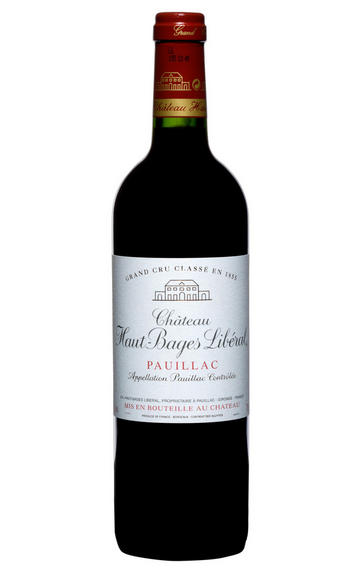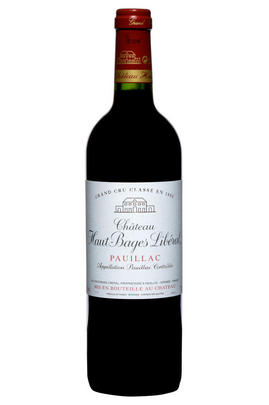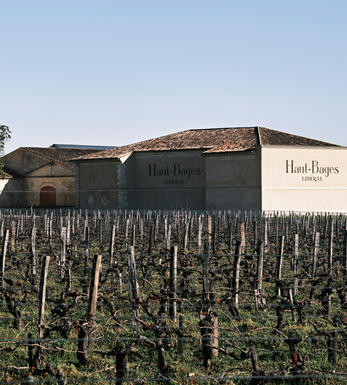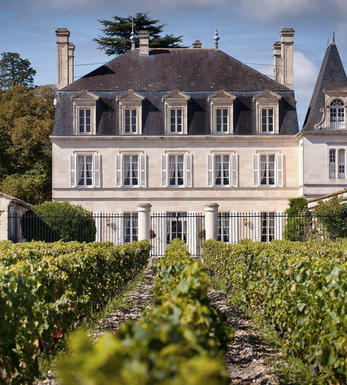
2009 Château Haut-Bages Libéral, Pauillac, Bordeaux

Critics reviews
Robert M. Parker, Jr. - 29/02/2012
Jancis Robinson MW - jancisrobinson.com - April 2010
James Suckling - Wine Spectator - March 2010
Robert Parker - Wine Advocate - Feb 2012
Steven Spurrier - Decanter - April 2010
About this WINE

Château Haut-Bages Libéral
Château Haut-Bages Libéral is a Fifth Growth in Pauillac owned and run by Claire Villars-Lurton and her husband Gonzague Lurton. It is one of the couple’s three Classified Growths in the Médoc with biodynamic certification, along with Château Durfort-Vivens and Château Ferrière. The 30-hectare property sits next door to Château Latour; the two are the only Pauillac estates with parcels of limestone soils, thought to lend elegance and finesse in a commune often known for power. The vineyard is planted to a majority of Cabernet Sauvignon, complemented by Merlot.
Though it has a long history, Haut-Bages Libéral has come into its own since 2000, when Claire came on board after the tragic death of her parents. Under her leadership, the property is making perhaps its best-ever wines. In the cellar, Claire works with some striking diamond-shaped amphorae, made from Limoges porcelain.
“Claire is one of the most creative and instinctive winemakers in Bordeaux, and you can really feel this now in her wines,” says Max Lalondrelle, our Bordeaux Buyer.

Pauillac
Pauillac is the aristocrat of the Médoc boasting boasting 75 percent of the region’s First Growths and with Grand Cru Classés representing 84 percent of Pauillac's production.
For a small town, surrounded by so many familiar and regal names, Pauillac imparts a slightly seedy impression. There are no grand hotels or restaurants – with the honourable exception of the establishments owned by Jean-Michel Cazes – rather a small port and yacht harbour, and a dominant petrochemical plant.
Yet outside the town, , there is arguably the greatest concentration of fabulous vineyards throughout all Bordeaux, including three of the five First Growths. Bordering St Estèphe to the north and St Julien to the south, Pauillac has fine, deep gravel soils with important iron and marl deposits, and a subtle, softly-rolling landscape, cut by a series of small streams running into the Gironde. The vineyards are located on two gravel-rich plateaux, one to the northwest of the town of Pauillac and the other to the south, with the vines reaching a greater depth than anywhere else in the Médoc.
Pauillac's first growths each have their own unique characteristics; Lafite Rothschild, tucked in the northern part of Pauillac on the St Estèphe border, produces Pauillac's most aromatically complex and subtly-flavoured wine. Mouton Rothschild's vineyards lie on a well-drained gravel ridge and - with its high percentage of Cabernet Sauvignon - can produce (in its best years) Pauillac's most decadently rich, fleshy and exotic wine.
Latour, arguably Bordeaux's most consistent First Growth, is located in southern Pauillac next to St Julien. Its soil is gravel-rich with superb drainage, and Latour's vines penetrate as far as five metres into the soil. It produces perhaps the most long-lived wines of the Médoc.
Recommended Châteaux
Ch. Lafite-Rothschild, Ch. Latour, Ch. Mouton-Rothschild, Ch. Pichon-Longueville Baron, Ch. Pichon Longueville Comtesse de Lalande, Ch. Lynch-Bages, Ch. Grand-Puy-Lacoste, Ch, Pontet-Canet, Les Forts de Latour, Ch. Haut-Batailley, Ch. Batailley, Ch. Haut-Bages Libéral.

Cabernet Sauvignon Blend
Cabernet Sauvignon lends itself particularly well in blends with Merlot. This is actually the archetypal Bordeaux blend, though in different proportions in the sub-regions and sometimes topped up with Cabernet Franc, Malbec, and Petit Verdot.
In the Médoc and Graves the percentage of Cabernet Sauvignon in the blend can range from 95% (Mouton-Rothschild) to as low as 40%. It is particularly suited to the dry, warm, free- draining, gravel-rich soils and is responsible for the redolent cassis characteristics as well as the depth of colour, tannic structure and pronounced acidity of Médoc wines. However 100% Cabernet Sauvignon wines can be slightly hollow-tasting in the middle palate and Merlot with its generous, fleshy fruit flavours acts as a perfect foil by filling in this cavity.
In St-Emilion and Pomerol, the blends are Merlot dominated as Cabernet Sauvignon can struggle to ripen there - when it is included, it adds structure and body to the wine. Sassicaia is the most famous Bordeaux blend in Italy and has spawned many imitations, whereby the blend is now firmly established in the New World and particularly in California and Australia.


Buying options
Add to wishlist
Description
With its fantastic texture and crunchy cassis fruit, Claire Villars-Lurton acquitted herself with honours with her 2009 Ch. Haut-Bages Libéral. This is a beautiful wine which wears its new oak seamlessly whilst a cleansing freshness and an intriguing earthy complexity add perfect balance. Punching well above its weight, this is destined to be a great value buy in 2009.
wine at a glance
Delivery and quality guarantee